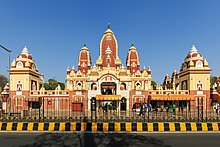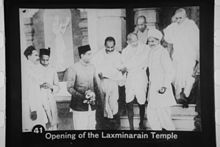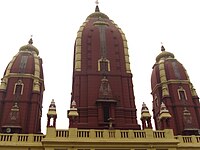The Birla family is a family connected with the industrial and social history of India.

Hanuman Temple in Connaught Place, New Delhi, India, is an ancient Hindu temple and is claimed to be one of the five temples of Mahabharata days in Delhi. The other four temples are the Kalkaji, a Kali temple in South Delhi containing Swayambu rock Idol, the Yogmaya Temple near Qutub Minar, the Bhairav temple near the Purana Qila and the Nili Chatri Mahadev at Nigambodh Ghat outside the walls of Old Delhi.
Prabhas Patan, also known as Somnath Patan, historically named Dev Patan, is locality situated in Veraval, Gir Somnath district in Saurashtra region of Gujarat, India. Somnath temple, a place of pilgrimage due to its importance as Jyotirlinga site dedicated to Shiva, is located here.
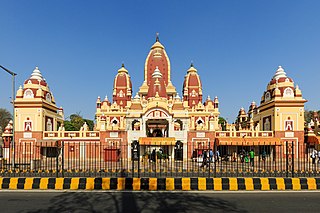
The Birla Mandirs refer to different Hindu temples or Mandirs built by the Birla family in different cities across India. All these temples are magnificently built, some in white marble or sandstone. The temples are generally located in a prominent location, carefully designed to accommodate a large number of visitors. The worship and discourses are well organized. The first one was built in 1939 in Delhi collectively by Jugal Kishore Birla and his brothers and their father. Later temples were built by and managed by different branches of the family. For both of the temples in Varanasi, the Birlas joined other donors to support the cost.
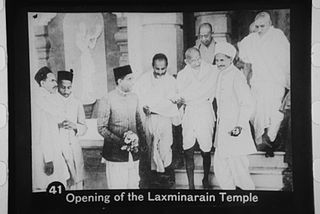
Baldeo Das Birla was an Indian entrepreneur. He contributed to the establishment of the Medical College Calcutta, and also built the Laxminarayan Temple, Delhi, also known as Birla Mandir, which was inaugurated by Mahatma Gandhi in 1939.

Birla Mandir is a Hindu temple, built on a 280 feet (85 m) high hillock called Naubath Pahad on a 13 acres (53,000 m2) plot in Hyderabad, Telangana, India. The construction took 10 years and was opened in 1976 by Swami Ranganathananda of Ramakrishna Mission. The temple was constructed by Birla Foundation, which has also constructed several similar temples across India, all of which are known as Birla Mandir.

Shri Swaminarayan Mandir, Mumbai is a Hindu temple (Mandir) and a part of the Swaminarayan Sampraday. This Swaminarayan Temple is located in the Bhuleshwar area of Mumbai and is the oldest Swaminarayan Mandir in Mumbai, being over a hundred years old.

Swaminarayan Mandir, Vadtal headquarters of the LaxmiNarayan Dev Gadi are located in this temple in Vadtal. There are three main shrines in the temple the central shirne of this temple is that of Lakshmi Narayan and RanchodRai. On the right there is idol of Radha Krishna with Swaminarayan in the form of Hari Krishna and the left has Vasudev, Dharma and Bhakti. The wooden pillars of the temple bear colourful wood carvings. There is a dharamsala within the temple premises. Gnyanbaug is a garden to the northwest of the temple gate that has four memorials dedicated to Swaminarayan.

Birla Mandir, Jaipur is a Hindu temple located in Jaipur, India and is one of many Birla mandirs. It was built by the B.M. Birla Foundation in 1988 and is constructed solely of white marble. It is dedicated to the Hindu goddess and Lakshmi and god Vishnu (Narayan), whose images appear inside, along with other Hindu gods and goddesses and selections from the Gita and Upanishads. It is located in Jaipur's Tilak Nagar neighborhood near Moti Dungari hill.

JK Temple is a Hindu temple in the Indian city of Kanpur, Uttar Pradesh, India. It is considered to be a unique blend of ancient and modern architecture. The mandapa of the temple has been constructed with high roof for adequate ventilation of light and air. The temple was constructed by JK Trust and major maintenance expenses of the temple also comes from the trust fund. The temple is also popularly known as Radhakrishna Temple.
New Delhi Kali Bari is a Hindu temple dedicated to Goddess Kali and the center for Bengali culture in New Delhi, India. Established in 1930s, it is situated on Mandir Marg, close to Laxminarayan Temple in Delhi.
Sheth Jugal Kishore Birla was a scion of the Birla family and the eldest son of Baldeo Das Birla. He was a noted industrialist, philanthropist and vocal supporter of Hindu philosophy.

Shri Vishwanath Mandir also known as Vishwanath Mandir, Vishwanath Temple, New Vishwanath Temple and Birla Temple is another prominent Hindu temple in the holy city of Varanasi. Hindus across India and abroad visit this particular Lord Shiva temple to offer prayer to the Lord Vishwanath for the well-being of their families, and eternal peace. Every Hindu must perform a specific ritualistic homage for the departed souls of their ancestors this requires them to undertake pilgrimage to the holy city of Varanasi. The temple is situated near the Banaras Hindu University. Therefore, the temple site and the neighbourhood is a major attraction among Hindu students and visitors touring Varanasi. Shri Vishwanath Mandir has the tallest temple tower in the world with the Shikhara's height being around 250 feet. The temple is colloquially called VT, an acronym of Vishwanath Temple. The temple is under direct administration of the BHU.
Laxmi Narayan Mandir or Lakshmi Narayan Temple may refer to the following Hindu temples dedicated to Lakshmi Narayan:

Moti Dungri is a Hindu temple complex dedicated to Lord Ganesha in Jaipur, Rajasthan. It was built in 1761 under supervision of Seth Jai Ram Paliwal. The temple is a popular tourist attraction in the city and is located next to the Birla Temple.
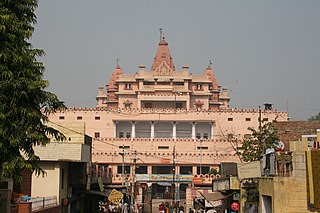
The Krishna Janmasthan Temple Complex is a group of Hindu temples situated in Mathura, Uttar Pradesh, India. There are three main temples inside the premises -- Keshavdevtemple which is dedicated to Krishna, Garbh Griha where Krishna is believed to be born in Dvapar Yuga and Bhagvata Bhavan where presiding deities are Radha Krishna.
